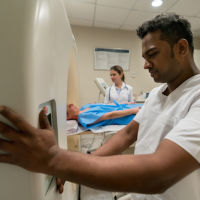Monitoring liver fat levels in obese patients who undergo weight loss treatments with MRI is noninvasive and safe, according to a new study published by the Radiological Society of North America.
In the United States more than two-thirds of the populations adults are overweight or obese, with conditions associated with obesity steadily becoming one of the most dangerous health issues in America.Common among obese patients is non-alcoholic fatty liver disease, a condition which can lead to cirrhosis and is proven to be associated with a higher risk of liver cancer.
You may also like: Study: whole body MRI is well-accepted by most patients
Among the more popular and proven effective weight loss interventions in obese patients are bariatric surgical procedures like gastric bypass and sleeve gastrectomy. Yet little is still known about the relationship between overall weight loss attributed to these treatments and the decreases in liver fat content. It is difficult to noninvasive measure liver fat, and over time the invasive nature of biopsies make it unfeasible for long term monitoring of changes in the liver.
This new study examined the liver fat before and following bariatric surgery procedures by using a promising new noninvasive imaging method known as quantitative chemical shift-encoded MRI (CSE-MRI). This technique measures liver fat by producing a proton density fat fraction (PDFF).
"CSE-MRI allows us to represent the measurement of liver fat as a percentage," said study coauthor Dr. B. Dustin Pooler, adjunct assistant professor at the University of Wisconsin School of Medicine and Public Health and radiologist at Madison Radiologists. "Each patient can get an assessment of fat throughout the liver that is easy for them to understand. The numbers also allowed us to perform comparisons with liver fat measurements from surgical and biopsy specimens."
Dr. Pooler and his team of colleagues performed CSE-MRI exams twice before a patient underwent surgery and then multiple times in the following year after the procedure. In addition, they compared the changes in liver fat as shown in the PDFF with the changes in patients body mass index (BMI), weight and weight circumference.
The researchers studied 50 obese patients who had undergone bariatric surgery for weight loss. These patients went on a low-calorie diet before surgery, an approach that has shown it can increase the safety and effectiveness of the surgical procedure.
The results showed that by six to ten months after the surgical procedure, mean PDFF in the study group lowered from 18 percent to approximately 5 percent when the normal range is 5 percent or less and mean BMI had decreased from 45 to 34.5. They estimated the mean time to normalisation of PDFF was about five months. The initial PDFF was the only strong predictor of both liver fat loss and time to normalisation.
"The results showed a rapid early phase of improvements in liver fat, followed by a phase of continued improvements at a slower pace," said Dr. Pooler. "The changes began with the initiation of the low-calorie diet and occurred in advance of the overall improvements in BMI among the patients."
The study results have led to many potential implications for the use of CSE-MRI in the management of obese patient care.
■ Advanced quantitative chemical shift-encoded MRI techniques can be used to noninvasively monitor longitudinal changes in liver fat content in severely obese adults.
■ In patients with severe obesity and hepatic steatosis, decreases in liver fat content (measured as proton density fat fraction by quantitative chemical shift-encoded MRI) were strongly correlated with pretreatment liver fat content, suggesting proton density fat fraction can help inform bariatric surgery patient selection.
■ Decreases in liver fat content were only weakly correlated with starting weight and the amount of overall weight loss, suggesting possible utility in monitoring liver fat with MRI following bariatric surgery, independent of monitoring weight loss.
"There is this assumption that when you lose weight you also reduce liver fat, but the relationship was very hard to measure prior to having a good tool like MRI," explained Dr. Pooler. "This study shows that the MRI technique is very clinically feasible for monitoring liver fat over time."
Dr. Pooler said the CSE-MRI technique could have applications beyond monitoring the effects of bariatric surgery.
"We looked at bariatric surgery patients in our study, but there's no reason this clinical tool can't be used to monitor all sorts of weight loss patients," he said. "We want patients and physicians to know that this is an option for them. We've done the validation and the next step is to make people more aware of this option."
Image Credit: iStock
Latest Articles
MRI, Radiology, RSNA, bariatric surgery, gastric bypass, Radiological Society of North America, liver fat, CSE-MRI, PDFF, sleeve gastrectomy, University of Wisconsin School of Medicine
Monitoring liver fat levels in obese patients who undergo weight loss treatments with MRI is noninvasive and safe, according to a new study published by the Radiological Society of North America.



























